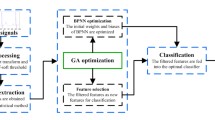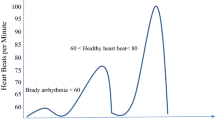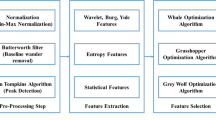Abstract
Arrhythmia is a form of heart disease in which the regularity of the pulse is changed.ECG data may be analyzed to detect heart-related illnesses or arrhythmias. This paper presents a wrapper feature selection strategy that employs a Pigeon-inspired optimizer(PIO). The modified Pigeon Inspired Optimizer (MPIO) is used to optimize ECG features and the Deep Neural Network (DNN) to classify the ECG signals. In MPIO, the new blood pigeons were introduced to improve the accuracy of the algorithm. Morphological features, wavelet transform coefficients, and R-R interval dynamic features are extracted for classification of ECG signals. After feature extraction, MPIO is used for feature optimization because optimizing the feature plays a key role in developing the model of machine learning, and irrelevant data features degrade model accuracy and enhance model training time. Using optimised features, the DNN classifier is utilised to classify ECG data. The proposed method achieves 99.10% accuracy, 98.90% specificity, and 98.50% sensitivity. Additionally, when compared with other state-of-the-art methodologies, our method of feature selection also exhibited better outcomes.












Similar content being viewed by others

References
Al Rahhal MM, Bazi Y, AlHichri H, Alajlan N, Melgani F, Yager RR (2016) Deep learning approach for active classification of electrocardiogram signals. Inform Sci 345:340–354
Alajlan N, Bazi Y, Melgani F, Malek S, Bencherif MA (2014) Detection of premature ventricular contraction arrhythmias in electrocardiogram signals with kernel methods. Signal, Image and Video Processing 8(5):931–942
Alcaraz R, Sandberg F, Sörnmo L, Rieta JJ (2011) Classification of paroxysmal and persistent atrial fibrillation in ambulatory ecg recordings. IEEE Trans Biomed Eng 58(5):1441–1449
Alonso-Atienza F, Morgado E, Fernandez-Martinez L, García-Alberola A, Rojo-Alvarez JL (2013) Detection of life-threatening arrhythmias using feature selection and support vector machines. IEEE Trans Biomed Eng 61(3):832–840
Baloglu UB, Talo M, Yildirim O, San Tan R, Acharya UR (2019) Classification of myocardial infarction with multi-lead ecg signals and deep cnn. Pattern Recogn Lett 122:23–30
Bhagyalakshmi V, Pujeri RV, Devanagavi GD (2021) Gb-svnn: genetic bat assisted support vector neural network for arrhythmia classification using ecg signals. Journal of King Saud University-Computer and Information Sciences 33(1):54–67
Celin S, Vasanth K (2018) Ecg signal classification using various machine learning techniques. Journal of Medical Systems 42(12):1–11
Chandrakar B, Yadav OP, Chandra VK (2013) A survey of noise removal techniques for ECG signals. International Journal of Advanced Research in Computer and Communication Engineering 2(3):1354–1357
Choi M, Seo M, Lee JS, Kim SW (2020) Fuzzy support vector machine-based personalizing method to address the inter-subject variance problem of physiological signals in a driver monitoring system. Artificial Intelligence in Medicine 105:101843
Daamouche A, Hamami L, Alajlan N, Melgani F (2012) A wavelet optimization approach for ecg signal classification. Biomedical Signal Processing and Control 7(4):342–349
Daqrouq K, Alkhateeb A, Ajour MN, Morfeq A (2014) Neural network and wavelet average framing percentage energy for atrial fibrillation classification. Computer Methods and Programs in Biomedicine 113(3):919–926
Das A Catthoor F Schaafsma S (2018) Heartbeat classification in wearables using multi-layer perceptron and time-frequency joint distribution of ecg. In: Proceedings of the 2018 IEEE/ACM international conference on connected health: applications, systems and engineering technologies, pp 69–74
Deng M, Wang C, Tang M, Zheng T (2018) Extracting cardiac dynamics within ecg signal for human identification and cardiovascular diseases classification. Neural Netw 100:70–83
Diker A, Cömert Z, Engin A (2017) A diagnostic model for identification of myocardial infarction from electrocardiography signals. Bitlis Eren University Journal of Science and Technology 7(2):132–139
Diker A, Avci E, Tanyildizi E, Gedikpinar M (2020) A novel ecg signal classification method using dea-elm. Medical Hypotheses 136:109515
Dorigo M, Birattari M, Stutzle T (2006) Ant colony optimization. IEEE Computational Intelligence Magazine 1(4):28–39
Duan H, Qiao P (2014) Pigeon-inspired optimization: a new swarm intelligence optimizer for air robot path planning. International Journal of Intelligent Computing and Cybernetics 7(1):24–37. https://doi.org/10.1108/IJICC-02-2014-0005
Elhaj FA, Salim N, Harris AR, Swee TT, Ahmed T (2016) Arrhythmia recognition and classification using combined linear and nonlinear features of ecg signals. Computer Methods and Programs in Biomedicine 127:52–63
Glass L (2006) Cardiac oscillations and arrhythmia analysis. In Complex Systems Science in Biomedicine. Springer, Boston, MA, pp 409–422. https://doi.org/10.1007/978-0-387-33532-2_16
Homaeinezhad MR, Atyabi SA, Tavakkoli E, Toosi HN, Ghaffari A, Ebrahimpour R (2012) Ecg arrhythmia recognition via a neuro-svm-knn hybrid classifier with virtual qrs image-based geometrical features. Expert Systems with Applications 39(2):2047–2058
Ince T, Kiranyaz S, Gabbouj M (2009) A generic and robust system for automated patient-specific classification of ecg signals. IEEE Transactions on Biomedical Engineering 56(5):1415–1426
Jiang J, Zhang H, Pi D, Dai C (2019) A novel multi-module neural network system for imbalanced heartbeats classification. Expert Systems with Applications: X 1:100003
Karaboga D, Akay B (2009) A comparative study of artificial bee colony algorithm. Applied Mathematics and Computation 214(1):108–132
Khosravy M, Gupta N, Patel N, Senjyu T, Duque CA (2020) Particle swarm optimization of morphological filters for electrocardiogram baseline drift estimation. In Applied nature-inspired computing: algorithms and case studies. Springer, Singapore, pp 1–21. https://doi.org/10.1007/978-981-13-9263-4_1
Kora P, Krishna KSR (2016) Hybrid firefly and particle swarm optimization algorithm for the detection of bundle branch block. International Journal of the Cardiovascular Academy 2(1):44–48
Korürek M, Doğan B (2010) Ecg beat classification using particle swarm optimization and radial basis function neural network. Expert Systems with Applications 37(12):7563–7569
Laguna P, Jané R, Olmos S, Thakor NV, Rix H, Caminal P (1996) Adaptive estimation of qrs complex wave features of ecg signal by the hermite model. Medical and Biological Engineering and Computing 34(1):58–68
Lake R (1981) Programs for digital signal processing. Proceedings of the IEEE 69(7):856–857
Li H, Feng X, Cao L, Li E, Liang H, Chen X (2016) A new ecg signal classification based on wpd and apen feature extraction. Circuits, Systems, and Signal Processing 35(1):339–352
Li H, Yuan D, Ma X, Cui D, Cao L (2017) Genetic algorithm for the optimization of features and neural networks in ecg signals classification. Scientific Reports 7(1):1–12
Li Z, Zhou D, Wan L, Li J, Mou W (2020) Heartbeat classification using deep residual convolutional neural network from 2-lead electrocardiogram. Journal of Electrocardiology 58:105–112
Mar T, Zaunseder S, Martínez JP, Llamedo M, Poll R (2011) Optimization of ecg classification by means of feature selection. IEEE Transactions on Biomedical Engineering 58(8):2168–2177
Mirjalili S, Lewis A (2016) The whale optimization algorithm. Advances in Engineering Software 95:51–67
Mondéjar-Guerra V, Novo J, Rouco J, Penedo MG, Ortega M (2019) Heartbeat classification fusing temporal and morphological information of ecgs via ensemble of classifiers. Biomedical Signal Processing and Control 47:41–48
Moody GB, Mark RG (2001) The impact of the mit-bih arrhythmia database. IEEE Engineering in Medicine and Biology Magazine 20(3):45–50
Neggaz N, Houssein EH, Hussain K (2020) An efficient henry gas solubility optimization for feature selection. Expert Systems with Applications 152:113364
Oh SL, Ng EY, San Tan R, Acharya UR (2018) Automated diagnosis of arrhythmia using combination of cnn and lstm techniques with variable length heart beats. Computers in Biology and Medicine 102:278–287
Pan J, Tompkins WJ (1985) A real-time qrs detection algorithm. IEEE Transactions on Biomedical Engineering 3:230–236
Sannino G, De Pietro G (2018) A deep learning approach for ecg-based heartbeat classification for arrhythmia detection. Future Generation Computer Systems 86:446–455
Shadmand S, Mashoufi B (2016) A new personalized ecg signal classification algorithm using block-based neural network and particle swarm optimization. Biomedical Signal Processing and Control 25:12–23
Silva I, Moody GB (2014) An open-source toolbox for analysing and processing physionet databases in matlab and octave. Journal of open research software 2(1). https://doi.org/10.5334/jors.bi
Singh YN (2015) Human recognition using fishers discriminant analysis of heartbeat interval features and ecg morphology. Neurocomputing 167:322–335
Übeyli ED (2009) Combining recurrent neural networks with eigenvector methods for classification of ecg beats. Digital Signal Processing 19(2):320–329
Wang G, Zhang C, Liu Y, Yang H, Fu D, Wang H, Zhang P (2019) A global and updatable ecg beat classification system based on recurrent neural networks and active learning. Information Sciences 501:523–542
Yildirim Ö (2018) A novel wavelet sequence based on deep bidirectional lstm network model for ecg signal classification. Computers in Biology and Medicine 96:189–202
Author information
Authors and Affiliations
Corresponding author
Ethics declarations
Conflict of interest
The authors declare that they have no conflict of interest.
Rights and permissions
About this article
Cite this article
Nainwal, A., Kumar, Y. & Jha, B. An ECG classification using DNN classifier with modified pigeon inspired optimizer. Multimed Tools Appl 81, 9131–9150 (2022). https://doi.org/10.1007/s11042-021-11594-5
Received:
Revised:
Accepted:
Published:
Issue Date:
DOI: https://doi.org/10.1007/s11042-021-11594-5



